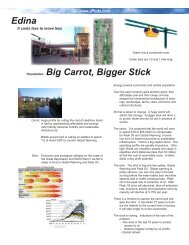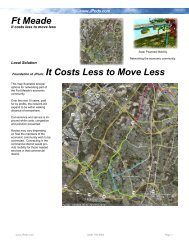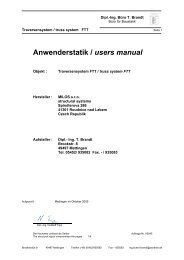FP5 PROJECTS - JPods
FP5 PROJECTS - JPods
FP5 PROJECTS - JPods
You also want an ePaper? Increase the reach of your titles
YUMPU automatically turns print PDFs into web optimized ePapers that Google loves.
4.3.1 Sustainable construction and reconstruction of large groups of buildings and urban infrastructure<br />
WAMBUCO (European Waste Manual for Building Construction)<br />
Project Reference: EVK4-CT-2002-30006 Start Date: 01-10-2002<br />
Contract Type: CRAFT End Date: 31-09-2004<br />
Project URL: http://www.wambuco.net Duration: 24 months<br />
Problems to be solved<br />
Scientific objectives and approach<br />
The overall goal of the production of a European Waste Manual for Building Construction which will be<br />
used as a tool by the building industry to optimise waste management during the building process. The<br />
specific aims of the project are:<br />
1. Producing planning aids incorporating trades-specific waste parameters in order to achieve a<br />
reduction of building waste by up to 25 per cent by weight.<br />
2. Optimising the separation of building-site waste and increasing the proportion of separated re-usable<br />
materials of more than 75 per cent by weight<br />
3. Reducing emissions produced by waste-disposal traffic by up to 40 per cent<br />
4. Increasing the productivity of all trades by more than 2 per cent<br />
5. Increasing the interest of building sponsors, architects and investors in a low-waste and recyclingoriented<br />
approach to building<br />
6. Reducing the amount of work required on the building site for the transport of materials and waste<br />
materials<br />
7. Reducing the threat accidents and fire on building sites<br />
8. Reducing resource and the cost of materials<br />
Within the framework of detailed country studies, approaches to low-waste and recycling-oriented building<br />
will be identified. Based in these approaches, an appropriate form of building waste management is to be<br />
developed and implemented in five countries within the European Union. In conjunction with training<br />
centres for the building trades, potentials for building-site waste avoidance in the case of building<br />
construction will be investigated at the level of individual trades.<br />
As first step, a central waste management logistics system for building projects will be established by the<br />
research institutions. The central waste management structure will connect all participating firms and<br />
waste management facility within the building project. On selected building sites, the research institutions<br />
will co-ordinate the collection by small and medium-sized building and waste management enterprises of<br />
data concerning building performance and waste potentials.<br />
Training and further training centres of the building industry will be involved in the research project. On<br />
their rehearsal construction sites, experimental programmes will be conducted focusing on the testing of<br />
low-waste building procedures. This will effect sensitivity towards waste avoidance, and lay the base for<br />
curriculum adaptation.<br />
The links between building performance and waste yield will be analysed for wall, ceiling, floor, facade,<br />
roof and cladding constructions. The building parameters influencing waste yield will be analysed, and<br />
optimisation measures involving variable material input will be conducted with regard to the use of<br />
materials and packaging,<br />
The research institutions will translate the waste-yield data provided by the two research programmes into<br />
key waste parameters relating to building practices. The results of the research project will then be<br />
compiled and presented in the form of a European Waste Manual for Building Construction.








